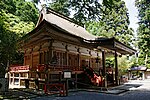| Toshigami | |
|---|---|
Harvest, grain | |
| Other names | Toshigami (大年神) |
| 年神 or 歳神 | Japanese |
| Personal information | |
| Parents |
|
| Siblings | Ukanomitama |
| Consorts |
|
| Offspring | Oyamakui no Kami |
Toshigami (年神 or 歳神, Toshigami or Tomo, lit. "year god"), also known as Ōtoshi-no-kami (大年神, lit. "great year god"), is a Japanese kami and a part of the Shinto pantheon.
YouTube Encyclopedic
-
1/3Views:1 634803408
-
Japanese New Year at Home [Episode 1/2]
-
【穏呪師】正月に年神様を迎えるエネルギー #shorts
-
Dontoyaki
Transcription
Etymology
The 年 (nen) kanji originally meant "harvest", which became "year" over time as harvest happened once each year. Toshigami was therefore the god of abundant harvests, and specifically of grain or rice.[1][2] The character 神 (kami) literally means "god" or "deity".
Mythology
Parentage and siblings
According to the Kojiki, Toshigami was the son of Susanoo and Kamuo Ichihime and the older brother of Ukanomitama.[1][2]
Family
Toshigami had offspring through three different wives: Ino-hime (伊怒比売), Kaguyo-hime (香用比売), and Amechikarumizu-hime (天知迦流美豆比売).[1] Through Ino-hime, his children include Ohokuni-mitama (大国御魂神), Kara-kami (韓神),[3] Sofuri-kami (曾富理神), Shirahi-no-kami (白日神), and Hijiri-no-kami (聖神). His children by Kaguyo-hime include Ōkaguyama-tomi (大香山戸臣神) and Mitoshi-no-kami (御年神). With Amechikarumizu-hime, he had Okitsu-hiko-no-kami (奥津日子神), Okitsu-hime-no-mikoto (奥津比売命), Oyamakui-no-kami (大山咋神),[4] Niwa-tsuhi-no-kami (庭津日神), Asuha-no-kami, Hahiki-no-kami, Kaguyama-tomi-no-kami (香山戸臣神), Hayamato-no-kami (羽山戸神), Niwataka-tsuhi-no-kami (庭高津日神), and Ōtsuchi-no-kami (大土神).
Family tree
- Pink is female.
- Blue is male.
- Grey means other or unknown.
- Clans, families, people groups are in green.
See also
References
- ^ a b c 大年神 [Ōtoshi-no-kami] (in Japanese). Kokugakuin University. Archived from the original on 5 June 2023. Retrieved 5 May 2023.
- ^ a b 大年神 [Ōtoshi-no-kami] (in Japanese). Kotobank. Archived from the original on 5 June 2023. Retrieved 5 May 2023.
- ^ 国安洋 (October 1989). 平安時代の「遊び」:「古今和歌集」をめぐって [Playing in the Heian Period: Disputing the "Kokin Wakashū"]. 横浜国立大学人文紀要 第一類 哲学・社会科学 (in Japanese). Yokohama National University. 35: 129–140. ISSN 0513-5621. Archived from the original on 6 June 2023.
- ^ "Ōtoshi | 國學院大學デジタルミュージアム". 2022-08-17. Archived from the original on 2022-08-17. Retrieved 2023-11-14.
- ^ Kaoru, Nakayama (7 May 2005). "Ōyamatsumi". Encyclopedia of Shinto. Retrieved 2010-09-29.
- ^ a b c Chamberlain (1882). Section XIX.—The Palace of Suga.
- ^ a b c Chamberlain (1882). Section XX.—The August Ancestors of the Deity-Master-of-the-Great-Land.
- ^ Atsushi, Kadoya (10 May 2005). "Susanoo". Encyclopedia of Shinto. Retrieved 2010-09-29.
- ^ "Susanoo | Description & Mythology". Encyclopedia Britannica.
- ^ a b c d e f g h i j k l m n o Herbert, J. (2010). Shinto: At the Fountainhead of Japan. Routledge Library Editions: Japan. Taylor & Francis. p. 402. ISBN 978-1-136-90376-2. Retrieved 2020-11-21.
- ^ a b 大年神 [Ōtoshi-no-kami] (in Japanese). Kotobank. Archived from the original on 5 June 2023. Retrieved 5 May 2023.
- ^ a b 大年神 [Ōtoshi-no-kami] (in Japanese). Kokugakuin University. Archived from the original on 5 June 2023. Retrieved 5 May 2023.
- ^ a b Mori, Mizue. "Yashimajinumi". Kokugakuin University Encyclopedia of Shinto.
- ^ Frédéric, L.; Louis-Frédéric; Roth, K. (2005). Japan Encyclopedia. Harvard University Press reference library. Belknap Press of Harvard University Press. ISBN 978-0-674-01753-5. Retrieved 2020-11-21.
- ^ a b c "My Shinto: Personal Descriptions of Japanese Religion and Culture". www2.kokugakuin.ac.jp. Retrieved 2023-10-16.
- ^ “‘My Own Inari’: Personalization of the Deity in Inari Worship.” Japanese Journal of Religious Studies 23, no. 1/2 (1996): 87-88
- ^ "Ōtoshi | 國學院大學デジタルミュージアム". 2022-08-17. Archived from the original on 2022-08-17. Retrieved 2023-11-14.
- ^ "Encyclopedia of Shinto - Home : Kami in Classic Texts : Kushinadahime". eos.kokugakuin.ac.jp.
- ^ "Kagutsuchi". World History Encyclopedia.
- ^ Ashkenazi, M. (2003). Handbook of Japanese Mythology. Handbooks of world mythology. ABC-CLIO. p. 213. ISBN 978-1-57607-467-1. Retrieved 2020-11-21.
- ^ Chamberlain, B.H. (2012). Kojiki: Records of Ancient Matters. Tuttle Classics. Tuttle Publishing. ISBN 978-1-4629-0511-9. Retrieved 2020-11-21.
- ^ Philippi, Donald L. (2015). Kojiki. Princeton University Press. p. 92.
- ^ Chamberlain (1882). Section XX.—The August Ancestors of the Deity-Master-Of-The-Great Land.
- ^ a b Ponsonby-Fane, R. A. B. (2014-06-03). Studies In Shinto & Shrines. Routledge. ISBN 978-1-136-89294-3.
- ^ a b "Encyclopedia of Shinto - Home : Kami in Classic Texts : Futodama". eos.kokugakuin.ac.jp. Retrieved 2021-07-13.
- ^ Philippi, Donald L. (2015). Kojiki. Princeton University Press. pp. 104–112.
- ^ Atsushi, Kadoya; Tatsuya, Yumiyama (20 October 2005). "Ōkuninushi". Encyclopedia of Shinto. Retrieved 2010-09-29.
- ^ Atsushi, Kadoya (21 April 2005). "Ōnamuchi". Encyclopedia of Shinto. Retrieved 2010-09-29.
- ^ a b The Emperor's Clans: The Way of the Descendants, Aogaki Publishing, 2018.
- ^ a b c Varley, H. Paul. (1980). Jinnō Shōtōki: A Chronicle of Gods and Sovereigns. Columbia University Press. p. 89. ISBN 9780231049405.
- ^ Atsushi, Kadoya (28 April 2005). "Kotoshironushi". Encyclopedia of Shinto. Retrieved 2010-09-29.
- ^ Sendai Kuji Hongi, Book 4 (先代舊事本紀 巻第四), in Keizai Zasshisha, ed. (1898). Kokushi-taikei, vol. 7 (国史大系 第7巻). Keizai Zasshisha. pp. 243–244.
- ^ Chamberlain (1882). Section XXIV.—The Wooing of the Deity-of-Eight-Thousand-Spears.
- ^ Tanigawa Ken'ichi 『日本の神々 神社と聖地 7 山陰』(新装復刊) 2000年 白水社 ISBN 978-4-560-02507-9
- ^ a b Kazuhiko, Nishioka (26 April 2005). "Isukeyorihime". Encyclopedia of Shinto. Archived from the original on 2023-03-21. Retrieved 2010-09-29.
- ^ a b 『神話の中のヒメたち もうひとつの古事記』p94-97「初代皇后は「神の御子」」
- ^ a b c 日本人名大辞典+Plus, デジタル版. "日子八井命とは". コトバンク (in Japanese). Retrieved 2022-06-01.
- ^ a b c ANDASSOVA, Maral (2019). "Emperor Jinmu in the Kojiki". Japan Review (32): 5–16. ISSN 0915-0986. JSTOR 26652947.
- ^ a b c "Visit Kusakabeyoshimi Shrine on your trip to Takamori-machi or Japan". trips.klarna.com. Retrieved 2023-03-04.
- ^ 『図説 歴代天皇紀』p42-43「綏靖天皇」
- ^ Anston, p. 143 (Vol. 1)
- ^ Grapard, Allan G. (2023-04-28). The Protocol of the Gods: A Study of the Kasuga Cult in Japanese History. University of California Press. ISBN 978-0-520-91036-2.
- ^ Tenri Journal of Religion. Tenri University Press. 1968.
- ^ Takano, Tomoaki; Uchimura, Hiroaki (2006). History and Festivals of the Aso Shrine. Aso Shrine, Ichinomiya, Aso City.: Aso Shrine.
External links
 The dictionary definition of toshigami at Wiktionary
The dictionary definition of toshigami at Wiktionary




